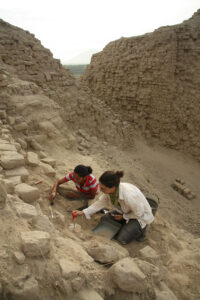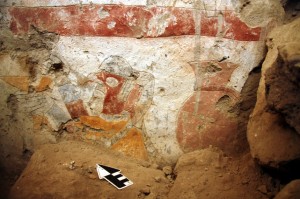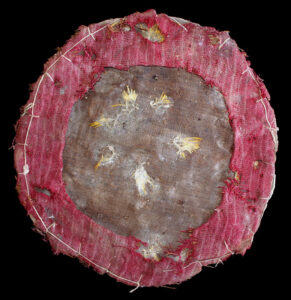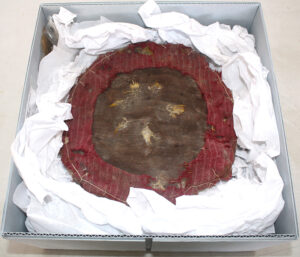Engaged Anthropology Grant: Lisa Trever
Lisa Trever is Assistant Professor of Visual Studies in the Department of History of Art at the University of California, Berkeley. In 2010, while a doctoral student at Harvard University, she received a Dissertation Fieldwork Grant to aid research on ‘The Agency of Images: Mural Painting and Architectural Sculpture on the North Coast of Peru,’ supervised by Dr. Thomas Bitting Foster Cummins. In 2014, she received the Engaged Anthropology Grant to return to Peru and organize a series of scholarly events and community-focused projects tied to her dissertation fieldwork.
My dissertation research project was an interdisciplinary study of wall painting, architectural configurations, and archaeological contexts at the Moche (or Mochica) site of Pañamarca (ca. 600–850 CE) on the north-central coast of Peru. This project consisted of archaeological reconnaissance, mapping, and excavation of ancient adobe temple walls painted with scenes of ritual processions, presentations of goblets, and mythological cycles of divine battles. Some of these mural paintings had been documented before, in the 1930s by Peruvian archaeologist Toribio Mejía Xesspe and in the 1950s by American archaeologist Richard Schaedel and Italo-Peruvian archaeologist Duccio Bonavia. Others were discovered by our field project.

Once excavated, my project’s work with the murals entailed conservation, extensive documentation through photography, pencil drawing, and watercolor, and my own close art historical study of the form and facture of each painted wall. The data gathered from this project formed the foundation of my dissertation “Moche Mural Painting at Pañamarca: A Study of Image Making and Experience in Ancient Peru,” which I completed in the History of Art and Architecture Department at Harvard University in 2013. This dissertation is a study of the Pañamarca mural paintings within the physical and social contexts of their architectural settings and the evidence for ritual activity documented in the form of material offerings within the painted temples.
I am now working with collaborators Jorge Gamboa Velásquez, Ricardo Toribio Rodríguez, and mural conservation advisor Ricardo Morales Gamarra to complete the book manuscript containing the complete findings of our fieldwork. The Archaeology of Mural Painting at Pañamarca will be published with a specialized press. At the same time, I am completing my own synthetic and analytical volume on wall painting and indexical evidence for ancient reception of and responses to painted images, tentatively titled Image Making and Experience in Ancient Peru.
Although these two publication projects are well under way, academic publishing of course takes time. It was thus very important for me to be able to return to Peru this year with the support of the Wenner-Gren Foundation to begin to share the results of this project with academic and regional audiences there. The Engaged Anthropology Grant allowed me to fly from San Francisco to Lima to present color photographs and prints of the watercolor illustrations of the murals that my project created to scholars and officials in the Ministerio de Cultura, the Pontificia Universidad Católica del Perú, the municipal Museo de Arte de Lima, and the Museo Larco. Each of these presentations began a series of conversations that continue to bear fruit as we think collaboratively about how best to exhibit the results of this project in Peru in the near future and how to plan for the future preservation of the site.

From Lima I then traveled north six hours to the city of Casma, where the archaeological collections from our project are stored in the Museo Regional “Max Uhle” at the site of Sechín. There I was again able to present photographs and images produced by my project to the museum director. The Engaged Anthropology Grant also permitted me to support the museum and other archaeologists working in the region of Ancash by funding the construction of a new storeroom for collections on the grounds of the museum. Secure storage space is at a premium at this small regional museum, as at many others. The new space will be a real benefit to the museum and to other research projects working in the region.
Also while in Casma I was able to assess the conditions of the packaging and storage of our collections to ensure their long-term preservation. I took the opportunity to perform some conservation work on the feathered shield we discovered at Pañamarca in 2010. This work consisted primarily in rehousing the shield in a sturdy archival box and with acid-free paper that I brought with me from the United States. I also installed a temperature and humidity monitor within the storeroom. During this museum stay I selected carbon samples from our collections and began the process of requesting government permission to export them to the United States for radiocarbon dating. That process was completed in November and the samples are presently on their way to the laboratory for testing.

Traveling further north from Casma to Trujillo, I continued my series of meetings with archaeologists and conservators working in the area, including some members of my own project whom I had not seen in nearly four years. The culminating moment of this two-week visit to Peru was a public, Spanish-language, lecture that I gave to a standing room only audience on a Friday evening at the Museo de Arqueología, Antropología e Historia of the Universidad Nacional de Trujillo. It was a tremendous honor to be given this forum to share the results of our intensive research project with colleagues, with anthropology and archaeology students, and with the community of Trujillo.

I am immensely grateful to the Wenner-Gren Foundation for its support of these activities and continued conversations about this research with Peruvian colleagues and stakeholders. These conversations are still ongoing several months later, as we are making new plans for future endeavors, conferences, seminars, and publications. The Engaged Anthropology Grant gave me the opportunity to cultivate these relationships, which are essential to research and to our common mission to discover and make known as much as we can about the ancient American past and the cultural and artistic traditions of its people.
